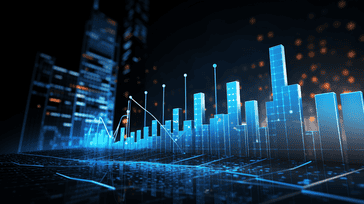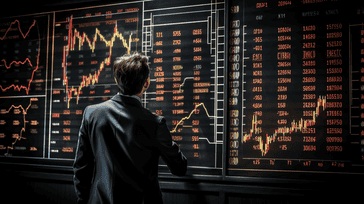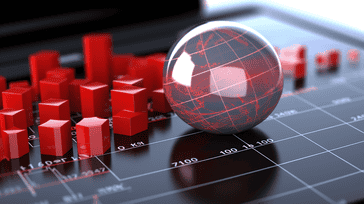Understanding the Business Cycle through Economic Indicators

As a business owner or investor, it is important to stay informed about the economy and its fluctuations. Economic indicators provide critical information that can help you understand the current state of the economy, anticipate changes, and make informed decisions.
Economic indicators are statistics that provide insights into the overall health and performance of the economy. These indicators can be used to track trends in various sectors such as employment, inflation, trade, and finance. By examining these indicators, businesses can get a better understanding of the business cycle and make informed decisions based on the current state of the economy.
In this section, we will explore the various economic indicators in detail and examine how they can help you navigate the changing economic landscape.
Key Takeaways
- Economic indicators are statistics that provide insights into the overall health and performance of the economy.
- These indicators can track trends in sectors such as employment, inflation, trade, and finance.
- Examining economic indicators allows businesses to understand the business cycle and make informed decisions based on the current state of the economy.
What are Economic Indicators?
When it comes to assessing the health of an economy, economic indicators are critical tools that experts rely on. Economic indicators are statistical measures that provide valuable information about various aspects of an economy, including its overall growth, employment levels, inflation rate, stock market performance, and more.
Economic indicators play a vital role in understanding the business cycle. By tracking these indicators, businesses can predict future trends, adapt their strategies, and make informed decisions. Economic indicators provide a snapshot of the economy, and they can give insight into how it has changed over time and how it may change in the future.
There are various types of economic indicators, including leading, coincident, and lagging indicators. Leading indicators are those that presage change in the economy and include things like retail sales, housing starts, and stock market trends. Coincident indicators measure the current state of the economy and include things like industrial production and employment data. Lagging indicators reflect changes that have already happened in the economy and include things like unemployment rates and GDP figures.
What are the most important Economic Indicators to track?
The most important economic indicators to track depend on the specific industry or sector you are interested in. However, some of the most widely tracked indicators include:
| Economic Indicator | Description |
|---|---|
| GDP Growth | The change in the country's gross domestic product (GDP) over time, which measures the nation's economic output. |
| Unemployment Rate | The percentage of the labor force that is currently unemployed, measuring the health of the job market. |
| Inflation Rate | The rate at which the general price level of goods and services is increasing, indicating the cost of living and the purchasing power of the currency. |
| Consumer Price Index (CPI) | A measure of the average price level of a basket of goods and services purchased by households, used as a tool to track inflation. |
| Stock Market Performance | The performance of major stock market indices, indicating the level of investor confidence and reflecting corporate earnings and economic activity. |
| Interest Rates | The cost of borrowing money, which affects consumer spending, business investment, and inflation. |
| Trade Balance | The difference between a country's imports and exports, reflecting the state of its international trade relations and competitiveness. |
Overall, economic indicators are vital tools for businesses and policymakers to assess the state of the economy and gain insights into trends and changes. By tracking these indicators, businesses can make informed decisions, adapt strategies, and prepare for economic cycles.
GDP Growth as an Economic Indicator

Gross Domestic Product (GDP) is the total market value of all goods and services produced in a country in a given period. It is one of the most crucial economic indicators that measures the economic growth of a country. GDP is calculated by adding up the value of all final goods and services produced within a country, regardless of whether the production took place by a citizen or a foreigner.
GDP growth tells us how much output has increased or decreased compared to the previous quarter or year. A positive GDP growth means that the country is producing more goods and services, indicating a healthy economy. Conversely, a negative GDP growth means a contracting economy, which could be a sign of a recession.
Calculating GDP
There are three ways to calculate GDP:
| Method | Description |
|---|---|
| Output Approach | Adding up the value of all goods and services produced in the country. |
| Income Approach | Adding up the income earned by all producers of goods and services in the country. |
| Expenditure Approach | Adding up all the spending on goods and services in the country, including consumption, investment, government spending, and net exports. |
Interpreting GDP Growth
GDP growth is a key economic indicator because it reflects the overall health and growth of an economy. A high GDP growth rate indicates a strong economy, while a low GDP growth rate indicates a weak economy. However, it is essential to interpret the GDP growth rate in conjunction with other economic indicators to understand the full picture of the economy.
For example, if the GDP growth rate is high, but the inflation rate is also high, it can indicate that the economy is overheating, and the central bank may need to raise interest rates to curb inflation. On the other hand, if the GDP growth rate is low, but the unemployment rate is also low, it may indicate that the economy is at full employment, and the central bank may need to lower interest rates to stimulate growth.
In conclusion, GDP growth is a vital economic indicator that reflects the overall health and growth of an economy. It is calculated in three ways, and interpreting it requires considering other economic indicators to gain a full understanding of the economy.
Unemployment Rate as an Economic Indicator
The unemployment rate is one of the key economic indicators used to assess the overall health of a country's economy. It measures the percentage of the labor force that is unemployed and actively seeking employment. A high unemployment rate can indicate a weak job market and a struggling economy, while a low unemployment rate can suggest a strong job market and a healthy economy.
To calculate the unemployment rate, the number of unemployed individuals is divided by the total number of individuals in the labor force, which includes both employed and unemployed individuals who are actively seeking employment. The resulting number is then multiplied by 100 to obtain a percentage.
According to the Bureau of Labor Statistics, the current unemployment rate in the United States is 5.8%, as of May 2021.
The unemployment rate can provide valuable insights into the overall state of the economy. For example, during a recession, the unemployment rate tends to rise, as companies reduce their workforce and individuals struggle to find employment. Conversely, during a period of economic growth, the unemployment rate tends to fall, as companies hire more workers to meet increased demand.
The unemployment rate can also provide insights into specific sectors of the economy. For instance, a high unemployment rate in certain industries, such as manufacturing or construction, could suggest these sectors are struggling, while a low unemployment rate in other sectors, such as healthcare or technology, could suggest these sectors are thriving.
Overall, the unemployment rate is a crucial economic indicator that can help businesses, policymakers, and investors make informed decisions. By monitoring changes in the unemployment rate over time, businesses can assess the strength of the job market and adjust their hiring strategies accordingly, while policymakers can use this information to implement policies that aim to stimulate job growth and improve economic conditions.
Inflation Rate and the Consumer Price Index (CPI)

When it comes to economic indicators, inflation rate and the consumer price index (CPI) are two important measures that provide insight into the health and stability of an economy.
Inflation rate refers to the rate at which the general level of prices for goods and services is rising, and is typically measured as a percentage increase over a certain period of time. When inflation is high, consumers may have to pay more for goods and services, while businesses may experience cost pressures and reduced profitability.
The Consumer Price Index (CPI) is a measure of the average change over time in the prices paid by urban consumers for a basket of goods and services. The CPI is widely used as a gauge of inflationary trends because it tracks the prices of a wide range of consumer goods and services, including housing, transportation, food, and medical care. By comparing the CPI over different periods, we can determine whether or not prices are generally rising or falling.
Table: Changes in Inflation Rate and CPI
| Year | Inflation Rate | CPI |
|---|---|---|
| 2018 | 2.5% | 252.146 |
| 2019 | 1.8% | 255.657 |
| 2020 | 0.3% | 258.115 |
As we can see in the table above, the inflation rate has been gradually decreasing, from 2.5% in 2018 to 0.3% in 2020. At the same time, the CPI has continued to increase, indicating that consumer prices are still rising, albeit at a slower pace.
This trend has important implications for businesses and consumers alike. For businesses, low inflation may signal weak demand, while high inflation may increase production costs. For consumers, high inflation can reduce purchasing power, while low inflation may encourage spending and investment.
"Inflation is as violent as a mugger, as frightening as an armed robber, and as deadly as a hitman." - Ronald Reagan
Overall, inflation rate and the Consumer Price Index are important economic indicators that can provide valuable insights into the overall health and trends of an economy. By monitoring these indicators, businesses can make informed decisions about pricing, investment, and production, while consumers can make informed decisions about spending and saving.
Stock Market Performance as an Economic Indicator
The stock market serves as an important economic indicator by reflecting the overall state of the economy and investor sentiment. It provides valuable insights into the health of various sectors of the economy, such as technology, finance, and retail.
Changes in the stock market reflect the buying and selling decisions of investors, as well as their expectations for future economic conditions. When the market is up, investors are generally optimistic about the economy, and vice versa.
There are several stock market indices that are used to track the performance of various sectors of the market, such as the Dow Jones Industrial Average (DJIA), the S&P 500, and the NASDAQ Composite Index. These indices provide investors with an easy way to measure the overall performance of the market and track trends over time.
| Stock Market Index | Description |
|---|---|
| DJIA | Average of 30 large-cap stocks |
| S&P 500 | Tracks the performance of 500 large-cap stocks |
| NASDAQ Composite Index | Tracks the performance of over 3,000 technology and growth-oriented companies |
By analyzing the movements of these indices, investors can gain insights into the performance of various sectors of the economy. For example, the NASDAQ Composite Index is heavily influenced by the technology sector, while the DJIA is comprised of large industrial companies.
Overall, the stock market serves as a useful economic indicator for businesses and investors alike. By monitoring the performance of various sectors of the market, businesses can gain insights into the overall health of the economy and make informed decisions.
Interest Rates and Their Impact on the Economy

Interest rates are a critical economic indicator that affects borrowing, lending, and spending decisions. The Federal Reserve plays a crucial role in setting interest rates in the US.
The Federal Reserve's monetary policy decisions impact the economy in many ways. Changes in interest rates can lead to changes in the supply of money, which can then impact aggregate demand, inflation, and ultimately economic growth.
How Interest Rates Affect Borrowers and Lenders
When interest rates are low, borrowing becomes cheaper, and individuals and businesses are likely to borrow more money to finance investments and purchases, leading to an increase in demand. On the other hand, when interest rates are high, borrowing becomes more expensive, and demand for loans decreases. Savings become more attractive, and individuals and businesses are more likely to save money and delay borrowing or spending.
Changes in interest rates also have a significant impact on lenders. Banks and other financial institutions are likely to increase their lending when interest rates are low, due to higher demand for loans. In contrast, when interest rates are high, financial institutions may be more inclined to hold onto their funds or invest in low-risk securities.
How Interest Rates Affect Investment Decisions
Interest rates can also affect investment decisions. Higher interest rates make it more expensive to borrow money to fund investment projects, which can lead to a decrease in business investment. On the other hand, lower interest rates can encourage businesses to take on new investment projects, leading to an increase in business investment.
How Interest Rates Affect Consumer Spending
Interest rates can also impact consumer spending decisions. When interest rates are low, it becomes cheaper for individuals to finance purchases through loans and credit, leading to an increase in consumer spending. However, when interest rates are high, the cost of borrowing increases, and consumers may be more hesitant to make costly purchases, leading to a decrease in consumer spending.
Conclusion
Interest rates are a critical economic indicator that has a significant impact on various sectors of the economy, including borrowing costs, investment decisions, and consumer spending. By monitoring changes in interest rates, businesses can gain valuable insights into market conditions and make informed decisions that can help them navigate economic cycles effectively.
Trade Balance as an Economic Indicator
The trade balance is a crucial economic indicator that reflects a country's international trade relationships, competitiveness, and economic health. It represents the difference between a country's exports and imports over a given period.
A positive trade balance, also known as a trade surplus, occurs when a country's exports exceed its imports, indicating a strong economy and competitive export industries. On the other hand, a negative trade balance, or trade deficit, occurs when a country's imports exceed its exports, indicating a weak economy and potential currency devaluation.
The table below shows the trade balance of the United States from 2016 to 2020:
| Year | Exports | Imports | Trade Balance |
|---|---|---|---|
| 2016 | $2.21 trillion | $2.74 trillion | -$525 billion |
| 2017 | $2.34 trillion | $2.90 trillion | -$568 billion |
| 2018 | $2.50 trillion | $3.12 trillion | -$621 billion |
| 2019 | $2.50 trillion | $2.95 trillion | -$451 billion |
| 2020 | $2.11 trillion | $2.83 trillion | -$723 billion |
As seen from the table, the United States has consistently held a trade deficit, which has increased over the years.
A significant increase in the trade deficit may indicate a higher demand for goods and services, but also an increase in imports, which may harm domestic industries and employment. Alternatively, a decrease in the trade deficit may indicate a decline in demand for goods and services, but also a more competitive export industry and improving economic health.
Therefore, businesses must keep a close eye on the trade balance and its trends to make informed business decisions and stay competitive in a constantly changing global market.
Housing and Labor Market Indicators
In addition to the indicators we have already discussed, we can also gain insights into the state of the economy by examining housing and labor market indicators.
Housing Market Indicators
The housing market is a critical sector of the economy, providing employment opportunities and driving economic growth through construction and sales. Here are some of the key indicators to monitor:
| Indicator | Description |
|---|---|
| Home Sales | The number of home sales in a given period, which can indicate the demand and supply of homes in the market. |
| Home Prices | The median price of homes sold in a given period, which can reflect the state of the housing market and the overall economy. |
| Housing Starts | The number of new residential construction projects that have begun, which can indicate the level of investment and demand in the housing market. |
| Mortgage Rates | The interest rates on mortgages, which can impact the demand for homes and indicate the state of the broader economy. |
Labor Market Indicators
The labor market is another critical aspect of the economy, providing employment opportunities and impacting consumer spending and overall economic growth. Here are some of the key labor market indicators to track:
| Indicator | Description |
|---|---|
| Unemployment Rate | The percentage of individuals in the workforce who are currently unemployed, which can indicate the state of the job market and the economy. |
| Job Openings | The number of available job openings, which can reflect the level of demand for labor and the overall state of the economy. |
| Labor Force Participation Rate | The percentage of individuals who are part of the labor force, which can indicate the level of engagement in the job market and the overall health of the economy. |
| Wage Growth | The rate of increase in wages, which can impact consumer spending and reflect the overall state of the economy. |
By monitoring these housing and labor market indicators, businesses can gain insights into the state of the housing market, job market, and broader economy. This information can help inform critical decisions about investments, hiring, and overall business strategy.
Conclusion
Understanding economic indicators is crucial for businesses to navigate the ever-changing economic landscape. By analyzing indicators such as GDP growth, unemployment rate, inflation rate, stock market performance, interest rates, trade balance, housing market indicators, and labor market indicators, businesses can gain valuable insights into the trends and health of the economy.
These economic indicators offer a glimpse into the future by predicting market trends. Companies can use these insights to make informed decisions about investments, hiring decisions, and expansion opportunities. Economic indicators also help businesses to predict economic downturns, allowing them to prepare and protect themselves from potential losses.
By continuously monitoring economic indicators, businesses can stay ahead of the competition, manage risks, and identify new opportunities. Economic indicators provide a real-time snapshot of the economy and its current state, enabling businesses to react quickly to changes in the market.
Stay Informed and Ahead of the Curve
To succeed in today's economy, businesses need to stay informed and ahead of the curve. Economic indicators serve as a valuable tool in this endeavor, providing businesses with valuable insights into the economy's health, trends, and future prospects. By integrating economic indicators into their decision-making processes, businesses can position themselves for long-term success and weather economic cycles with confidence and agility.
So, keep your eyes on the economic indicators, stay informed, and make data-driven decisions to thrive in today's economy!
FAQ
What are economic indicators?
Economic indicators are statistical measures that provide insights into the state of an economy. They help assess the health, growth, and overall performance of a country's economy.
What types of economic indicators are there?
There are various types of economic indicators, including GDP growth, unemployment rate, inflation rate, consumer price index (CPI), stock market performance, interest rates, trade balance, housing market indicators, and labor market indicators.
How is GDP growth calculated?
GDP growth represents the change in the value of all goods and services produced within a country over a specific period. It is calculated by comparing the current GDP to the previous period's GDP.
What does the unemployment rate indicate?
The unemployment rate measures the percentage of the labor force that is unemployed and actively seeking employment. It provides insights into the job market's health and the overall state of the economy.
What is inflation rate and how is it measured?
Inflation rate is a measure of the rate at which prices for goods and services rise over time. It is measured using the Consumer Price Index (CPI), which tracks changes in the prices of a basket of commonly purchased goods and services.
How does the stock market reflect the economy?
The stock market is often seen as a reflection of investor sentiment and economic performance. When stock prices rise, it indicates optimism and growth in the economy. Conversely, a decline may signal concerns or economic downturn.
How do interest rates impact the economy?
Changes in interest rates can affect borrowing costs, investment decisions, and consumer spending. Lower interest rates can stimulate economic growth, while higher rates can moderate inflation and encourage savings.
What does the trade balance indicate?
The trade balance represents the difference between a country's exports and imports. It provides insights into a country's international trade relationships, competitiveness, and economic health.
What do housing market indicators and labor market indicators reveal?
Housing market indicators provide insights into the state of the housing market, construction activity, and real estate trends. Labor market indicators shed light on employment trends, job creation, and workforce participation rates.